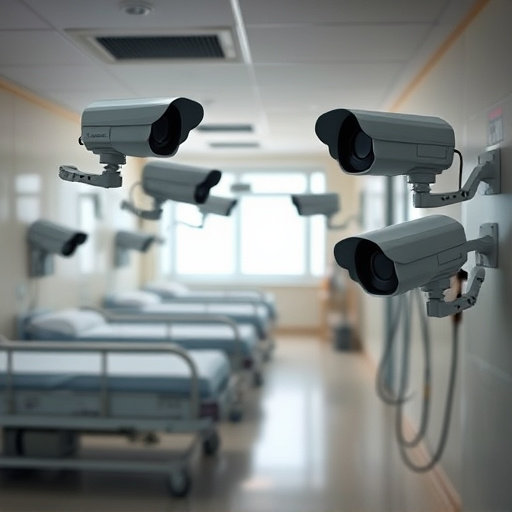Integrating technology, specifically security cameras, in senior living facilities is vital for enhancing safety and well-being. These cameras offer 24/7 monitoring, track resident movement, deter inappropriate behaviors, and assist in emergency responses. Wireless or wired options cater to diverse installation needs. While implementing cameras provides significant advantages like improved accountability and peace of mind, privacy concerns require strict protocols and data protection measures. When selecting cameras for nursing homes, prioritize high-definition video, night vision, audio recording, ease of use, and integration with existing technologies for optimal safety and efficiency.
In today’s digital age, the implementation of camera surveillance in senior living facilities has become increasingly vital. As populations age, ensuring the safety and well-being of residents is paramount. Cameras for nursing homes offer a comprehensive solution, enhancing security and peace of mind. This article delves into the critical need for these systems, exploring various types of cameras suitable for different senior care settings. We’ll also discuss the numerous benefits, address privacy concerns, and guide you in selecting the ideal camera system for your facility, ensuring compliance and optimal resident care.
Understanding the Need for Cameras in Senior Living Facilities
In today’s digital era, the integration of technology in senior living facilities has become increasingly vital to enhance safety and well-being. Cameras for nursing homes play a crucial role in achieving this goal. They offer a 24/7 monitoring system, ensuring the security and peace of mind of both residents and their families. With cameras strategically placed throughout common areas, corridors, and even individual rooms, staff can promptly respond to emergencies, track resident movement, and deter any potential issues or inappropriate behaviors.
The need for these surveillance systems is evident in addressing various concerns specific to senior living environments. Cameras can assist in identifying falls or accidents, monitoring medication administration, and preventing wanderlust, a common challenge for elderly residents with cognitive impairments. Moreover, they foster an environment of transparency and accountability, allowing staff to manage their duties more efficiently and providing families with valuable insights into their loved ones’ daily routines.
Types of Cameras for Nursing Homes: An Overview
Nursing homes and senior living facilities have unique security and surveillance needs, and the selection of appropriate cameras is essential to ensure resident safety and well-being. The market offers a range of camera types designed specifically for these environments, each with distinct advantages. From passive infrared (PIR) cameras that detect heat signatures for motion detection, to high-definition (HD) IP cameras providing clear, detailed footage, there’s a camera suited to every need.
Wireless and wired options are available, catering to different levels of flexibility and ease of installation. Wireless cameras offer convenience with their plug-and-play setup, while wired systems often provide better bandwidth for clearer video transmission and more advanced features like two-way audio communication. This variety allows facilities to tailor their surveillance solutions to their specific layouts, budgets, and security requirements.
Benefits of Implementing Camera Surveillance
Implementing camera surveillance in senior living facilities offers numerous benefits that enhance safety, security, and overall well-being. For nursing homes, cameras serve as a powerful tool to monitor vulnerable residents, ensuring their protection and peace of mind for both inhabitants and their families. With real-time video feeds, staff can swiftly respond to emergencies, track resident movement, and detect any unusual behavior or potential risks.
Moreover, these cameras promote a sense of security and independence among seniors. Knowing that their activities are discretely recorded encourages residents to adhere to safety protocols, while also providing valuable evidence in case of any incidents. Cameras for nursing homes contribute to improved accountability, allowing staff to monitor their shifts more effectively and ensuring consistent care quality throughout the day.
Addressing Privacy Concerns and Compliance
Implementing cameras in senior living facilities, especially nursing homes, raises valid privacy concerns among residents, families, and staff. It’s crucial to address these issues head-on to ensure compliance with data protection regulations like HIPAA (Health Insurance Portability and Accountability Act) in the US or similar laws worldwide. Clear communication about camera placement, purpose, and data security measures is essential. Residents and their families should be informed about what footage is captured, who has access to it, and for how long it’s stored.
Privacy can be maintained through strict protocols, such as limiting access to recorded footage only to authorized personnel for legitimate reasons, encrypting data storage, and ensuring camera angles focus on areas of interest rather than personal spaces. Regular reviews of surveillance policies and technology can help keep up with evolving privacy standards and protect the dignity and independence of senior living residents.
Choosing the Right Camera System for Your Senior Care Center
When selecting a camera system for your senior care center, consider its specific needs and preferences. Cameras for nursing homes should prioritize privacy, clarity, and reliability to ensure the comfort and safety of residents. Look for systems that offer high-definition video, night vision capabilities, and audio recording to facilitate close monitoring without compromising on resident dignity.
Additionally, ease of use and integration with existing technology are vital. Choose a system with intuitive software that allows staff to navigate effortlessly, view feeds from multiple locations simultaneously, and access recordings easily. Compatibility with other senior care technologies can enhance overall efficiency and contribute to a smoother operational flow in your facility.
